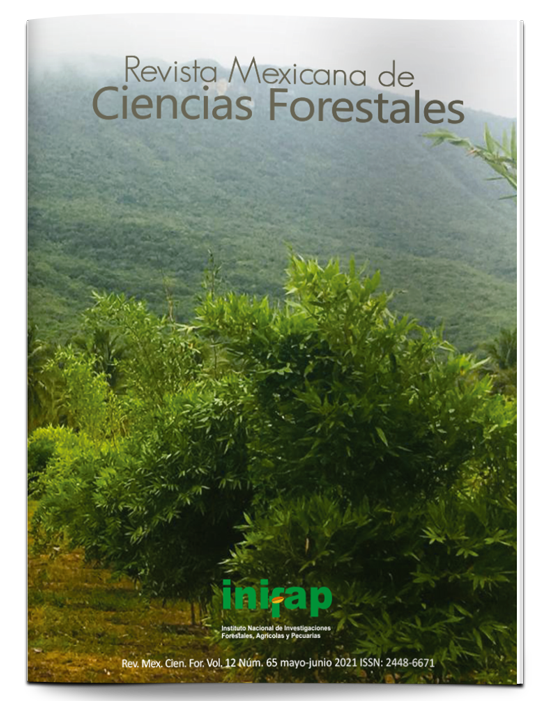Ecuaciones alométricas, biomasa y carbono en plantaciones forestales tropicales en la costa de Jalisco
DOI:
https://doi.org/10.29298/rmcf.v12i65.856Palabras clave:
Almacén de carbono, biomasa, diámetro normal, modelos alométricos, plantaciones tropicales, silviculturaResumen
La estimación de la biomasa aérea es una herramienta clave para determinar el potencial de almacenamiento de carbono de un taxón. En el occidente de México, se han establecido plantaciones forestales con especies tropicales, pero se desconoce el contenido y distribución de biomasa aérea seca, así como el almacenamiento de carbono. En este estudio se estimaron estos en plantaciones de 12 años de edad con los taxa nativos: Enterolobium cyclocarpum y Tabebuia rosea, e introducidas: Gmelina arborea y Tectona grandis, ubicadas en la Costa de Jalisco. Además, se ajustaron modelos lineales, potenciales y polinomiales de la relación de la biomasa aérea seca con respecto al diámetro normal. En las cuatro especies, la mayor proporción de la biomasa aérea seca (58-67 %) se obtuvo en el fuste. El diámetro normal resultó ser un buen predictor de la biomasa aérea seca total de las especies estudiadas, de las cuales dos se ajustaron a modelos potenciales y dos a modelos polinomiales, con los cuales es posible estimar dicho atributo de forma rápida, sencilla y a menor costo en comparación al método destructivo. T. grandis, G. arborea y E. cyclocarpum presentaron tanto el contenido de biomasa más alto (161 kg ha-1, 134 kg ha-1 y 130 kg ha-1), como el mayor potencial de almacenamiento de carbono: 144.6 Mg ha-1, 120.8 Mg ha-1 y 117.5 Mg ha-1, respectivamente. Las plantaciones forestales con estas especies pueden contribuir a la captura de carbono y mitigación del calentamiento global a largo plazo.
Descargas
Descargas
Publicado
Cómo citar
Número
Sección
Licencia
Los autores que publiquen en la Revista Mexicana de Ciencias Forestales aceptan las siguientes condiciones:
De acuerdo con la legislación de derechos de autor, la Revista Mexicana de Ciencias Forestales reconoce y respeta el derecho moral de los autores, así como la titularidad del derecho patrimonial, el cual será cedido a la revista para su difusión en acceso abierto.
Todos los textos publicados por la Revista Mexicana de Ciencias Forestales –sin excepción– se distribuyen amparados bajo la licenciaCreative Commons 4.0 Atribución-No Comercial (CC BY-NC 4.0 Internacional), que permite a terceros utilizar lo publicado siempre que mencionen la autoría del trabajo y a la primera publicación en esta revista. (no permite el uso comercial)
Los autores pueden realizar otros acuerdos contractuales independientes y adicionales para la distribución no exclusiva de la versión del artículo publicado en la Revista Mexicana de Ciencias Forestales (por ejemplo, incluirlo en un repositorio institucional o darlo a conocer en otros medios en papel o electrónicos) siempre que indique clara y explícitamente que el trabajo se publicó por primera vez en la Revista Mexicana de Ciencias Forestales.
Para todo lo anterior, los autores deben remitir el formato de carta-cesión de la propiedad de los derechos de la primera publicación debidamente requisitado y firmado por los autores/as. Este formato debe ser remitido en archivo PDF al correo: editorial.forestal@inifap.gob.mx
Esta obra está bajo una licencia de Creative Commons Reconocimiento-No Comercial 4.0 Internacional.






